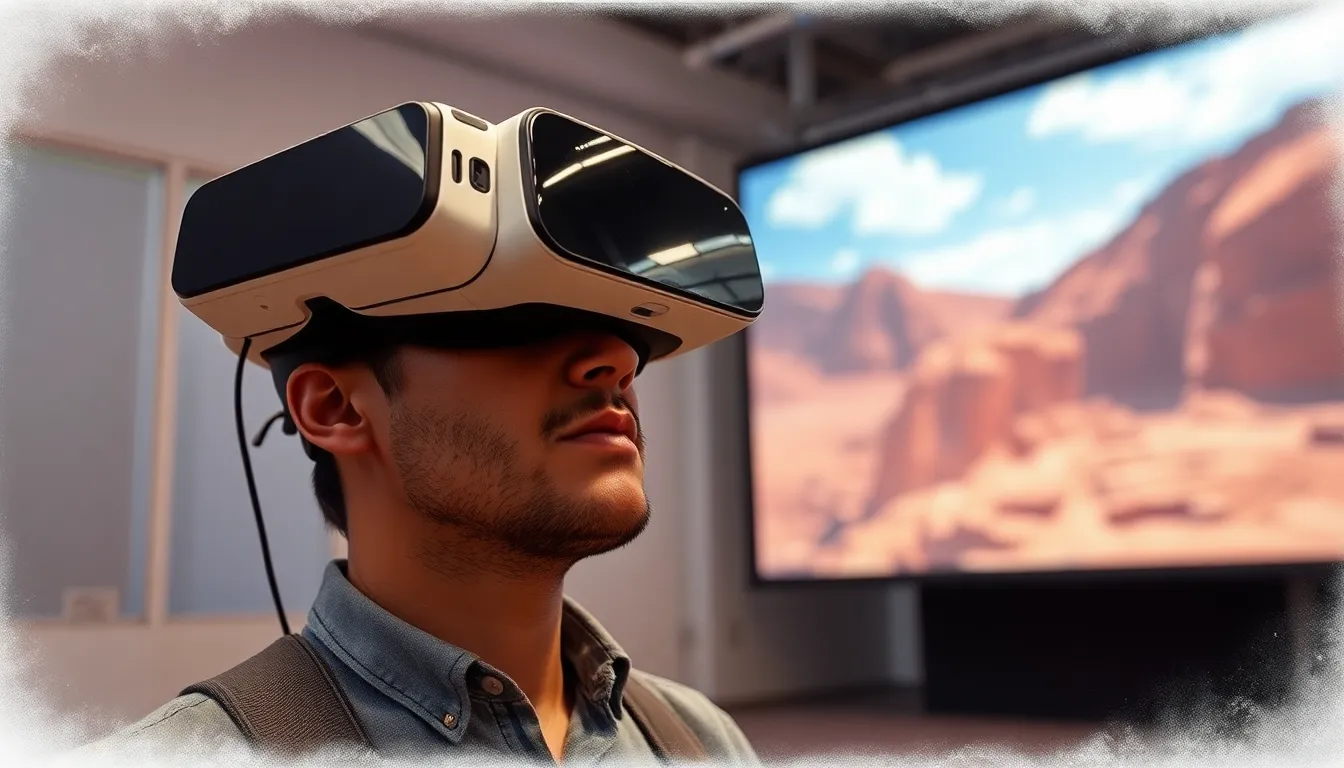Imagine stepping into a world where the mundane fades away, and the extraordinary takes center stage. Virtual reality displays are the magic portals that transport users to breathtaking landscapes, thrilling adventures, and even alternate realities—all without leaving the comfort of their living room. Whether it’s dodging asteroids in a space battle or exploring ancient ruins, these displays offer an immersive experience that traditional screens can only dream of.
Table of Contents
ToggleOverview of Virtual Reality Displays
Virtual reality displays serve as essential components in immersive environments, transforming how users interact with digital content. Various technologies contribute to the functionality of these displays, such as OLED and LCD screens, which enhance visual clarity and color accuracy. Specifically, high refresh rates of 90Hz or more help reduce motion blur, making movements feel smooth and lifelike.
The use of stereoscopic 3D technology creates depth perception, allowing users to experience environments more realistically. Motion tracking further elevates engagement by enabling users to look around and interact with virtual worlds naturally. This functionality is typically achieved through external sensors and internal gyroscopes or accelerometers.
Different types of virtual reality headsets exist, each designed for unique purposes. Standalone headsets offer a complete experience through built-in computing, while tethered headsets connect to gaming consoles or PCs for enhanced graphic rendering. Mobile VR headsets, utilizing smartphones, provide accessible entry points for users new to virtual reality.
Accessibility remains a primary focus, with a variety of options available in the market. Entry-level devices target casual users, while high-end systems cater to gamers and professionals seeking advanced experiences. As hardware improves and becomes more affordable, an expanded user base can explore virtual reality’s capabilities.
Furthermore, virtual reality displays find applications beyond entertainment. Industries like education, healthcare, and real estate leverage these technologies for training simulations, therapeutic treatments, and virtual tours. This broadens the horizons of how virtual reality impacts daily life and professional environments.
Types of Virtual Reality Displays

Virtual reality displays come in various forms, each offering unique experiences. Understanding these types helps users select the most suitable option for their needs.
Head-Mounted Displays
Head-mounted displays (HMDs) dominate the virtual reality landscape. They feature screens positioned close to the eyes, providing an immersive experience that envelops the user’s field of vision. These devices come in two main categories: tethered and standalone. Tethered HMDs connect to computers or consoles, offering powerful graphics and extensive content. Standalone HMDs function independently, equipped with processors and storage. Popular models include Oculus Quest 2 and HTC Vive Pro. Users can experience full 3D environments and interact in real-time. High-resolution optics and audio systems enhance immersion, making HMDs the primary choice for gamers and content creators.
Projection-Based Displays
Projection-based displays present another viable option for virtual reality experiences. They utilize projectors to display images on large surfaces or immersive domes, allowing multiple users to engage simultaneously. These setups often include motion tracking systems that ensure seamless interactions. Applications range from simulators for training to installations in museums and theme parks. Unlike HMDs, projection-based systems accommodate larger groups, making them ideal for collaborative experiences. Systems like the Cave Automatic Virtual Environment (CAVE) exemplify this technology. This approach fosters shared engagement and broader perspectives, appealing to educators and professionals seeking innovative presentations.
Key Technologies Behind Virtual Reality Displays
Virtual reality displays leverage key technologies to create immersive experiences. Two critical aspects of these technologies include display resolution and refresh rate.
Display Resolution
Resolution directly influences the clarity and detail of virtual environments. Higher resolutions lead to crisper images, enhancing realism for users. Common resolutions include 1080p, 1440p, and 4K, with many advanced headsets adopting 4K and above for unparalleled detail. As a reference, Oculus Quest 2 displays 1832 x 1920 per eye, providing sharp visuals. Increased resolution reduces the screen-door effect, a common issue that detracts from immersion. Users benefit from clearer text and finer details that elevate the overall experience in simulations and games alike.
Refresh Rate and Latency
Refresh rate significantly affects motion fluidity within virtual experiences. Typically, VR displays operate at rates of 60Hz to 120Hz or more. Higher refresh rates, like 90Hz or 120Hz, prevent motion blur and enhance responsiveness, crucial for realistic interactions. For instance, the Valve Index features a remarkable 144Hz refresh rate, enabling smooth gameplay. Conversely, latency measures the delay between user movements and visual response. Lower latency ensures seamless movements for users, reducing discomfort or motion sickness during extended sessions. Ideal latency is below 20ms, providing an intuitive experience in dynamic virtual settings.
Applications of Virtual Reality Displays
Virtual reality displays serve diverse applications that extend beyond gaming and entertainment. They provide immersive experiences across multiple sectors, enhancing engagement and effectiveness in various fields.
Gaming and Entertainment
Gaming represents one of the most popular applications of virtual reality displays. Gamers experience adventures that transport them into alternate worlds, enriching gameplay. Virtual reality titles like “Beat Saber” and “Half-Life: Alyx” showcase rich graphics and responsive environments, captivating players. Through immersion, users participate in games in a way that traditional screens cannot replicate. Social experiences also flourish, with multiplayer options allowing friends to connect in virtual environments. Michael Pachter, an industry analyst, notes that the VR gaming market is expected to reach $22.9 billion by 2025, highlighting its growing significance.
Education and Training
Education benefits significantly from virtual reality displays. Students engage with interactive content that enhances learning retention, making abstract subjects more tangible. Medical training programs often utilize VR simulations to provide hands-on experiences without risk. Fields like engineering leverage VR to visualize complex structures and processes, facilitating understanding. Additionally, virtual field trips offer students immersive experiences of distant locations and historical events. According to a report by PwC, VR training can improve retention rates by up to 75%, underscoring its value in educational settings.
Challenges and Limitations
Virtual reality displays face various challenges that impact user experience and accessibility. Understanding these limitations can help improve future developments.
Motion Sickness
Motion sickness presents a common issue for many users. Symptoms often arise due to a disconnect between visual motion and physical sensation, causing discomfort. It becomes particularly problematic during fast movements or virtual environments that clash with real-world perceptions. Developers aim to mitigate this by creating smoother frame rates and reducing latency. Techniques such as adjusting field of view can also help lessen nausea. Research indicates that nearly 40% of users may experience some level of motion sickness, underscoring the need for ongoing technological improvements.
Cost and Accessibility
Cost remains a significant barrier to widespread adoption of virtual reality displays. High-quality headsets can range from $300 to over $1,000, limiting accessibility for many potential users. Some consumers may not invest in additional equipment, such as powerful computers or consoles, needed to run advanced VR systems. Furthermore, many software options require separate purchases, adding to overall expenses. Accessibility is also influenced by factors such as physical space requirements for setup and individual user needs. Addressing these financial and practical limitations is vital for broadening VR’s reach across various demographics.
Virtual reality displays are reshaping how people interact with digital content. Their ability to provide immersive experiences makes them invaluable across various fields. As technology continues to evolve, the potential applications of VR will expand even further.
While challenges like motion sickness and high costs remain, ongoing advancements promise to enhance accessibility and user experience. The future of virtual reality looks bright, with opportunities for growth in entertainment, education, and beyond. Embracing these innovations will unlock new possibilities, making virtual reality an integral part of daily life.




